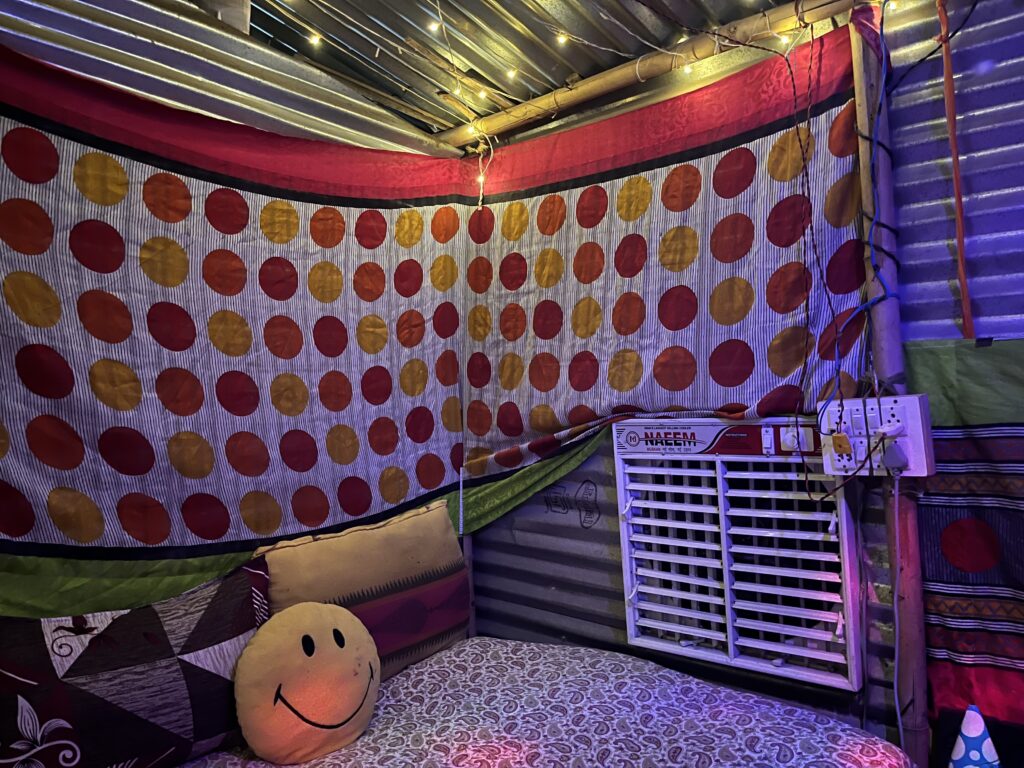Hot nights are worsening India’s heat crisis. But low-tech solutions show some promise.
Description
Editor’s note: This story is the culmination of a two-part series. To hear the first part, click on the audio player above, and listen to part two below.
<figure class="wp-block-audio"></figure>
For Merina Yasmin and her husband and 5-year-old daughter, who live in a one-room home in an informal settlement on the edge of Delhi, sleepless nights have become all too common in the summer.
Her home is made of tin sheets that heat up under the scorching sun all day and remain warm even after sunset. The room doesn’t have windows or a refrigerator, and the only source of relief is a desert cooler — a device with a fan and a water tank that blows cool air by evaporating water.
But even that is unreliable because of frequent power cuts.
Yasmin said that she looks forward to going to work, because it’s her only escape from the heat. She is a domestic worker for families who have air conditioning. But after washing their dishes and mopping their floors all day, she can’t even catch some rest because of the heat in her own home.
“Sometimes, I don’t feel like I am a human being,” she said.
Summer is in full swing in India, and many cities are experiencing scorching heat. And in India’s bustling cities, as the sun goes down and the worst of the day’s heat is over, an insidious threat looms: high nighttime temperatures. But some low-tech solutions may help address the problem.
Avikal Somvanshi, a researcher who studies heat stress in urban India, said that India has always been hot but this kind of heat is not normal.
<figure class="wp-block-image size-large">
 <figcaption class="wp-element-caption">The inside of Merina Yasmin’s home with bedsheets to protect from the hot metal surface.Sushmita Pathak/The World</figcaption></figure>
<figcaption class="wp-element-caption">The inside of Merina Yasmin’s home with bedsheets to protect from the hot metal surface.Sushmita Pathak/The World</figcaption></figure>“Climate change is actually fueling the heat waves,” he said.
It’s making them longer and more frequent, he said.
This year, heat waves in India began occurring as early as February, and many states are experiencing temperatures above 100 degrees Fahrenheit. Last June, Delhi recorded its hottest night in over 50 years with a low of 95 degrees.
Across Indian cities, nighttime temperatures are higher than they were 15 years ago, according to a 2024 analysis by the Centre for Science and Environment in Delhi, of which Somvanshi was a contributor.
Cities tend to be hotter than their surrounding rural areas even in the day, because of the way they’re built. The concrete, urban environment traps and radiates heat, and there’s less green cover to offset it.
But even greener parts of Delhi are seeing elevated nighttime temperatures.
“Having tree cover can help you get shade during the daytime temperature, but it seems to be totally ineffective in cooling down things at night,” Somvanshi said.
To make things worse, urban India’s densely packed homes offer little ventilation.
“We’re really starting to reach the temperatures and humidity levels that we associate with a potential unlivable situation,” said Caroline Buckee, an epidemiologist at Harvard University who is studying the health effects of extreme heat in India.
“Even if the temperature outside comes down, the housing itself absorbs the heat in the day, and then, it doesn’t cool down at night,” Buckee said. “And so, the temperature is remaining essentially constant throughout the day and night.”
The situation is especially detrimental for people like Yasmin, one of the millions of women who are part of India’s informal economy. They face grueling temperatures and yet, how it affects their health isn’t fully understood, Buckee said.
“Really, there are some glaring gaps when it comes to the physiological impacts of heat on women, on the reproductive health of women, and most importantly, of people who live in places most affected by climate change, where extreme heat is becoming more and more of a problem,” Buckee said.
To bridge this data gap, she and her colleagues are conducting a study in the western Indian city of Ahmedabad. They have given Fitbits to hundreds of female workers there to monitor their physical stress.
<figure class="wp-block-image size-large">
 <figcaption class="wp-element-caption">The inside of Merina Yasmin’s home.Sushmita Pathak/The World</figcaption></figure>
<figcaption class="wp-element-caption">The inside of Merina Yasmin’s home.Sushmita Pathak/The World</figcaption></figure>They’ve also put microsensors in their homes and workplaces to see how hot it gets throughout the day. Their study is ongoing but the initial findings are worrying.
“Compared to official meteorological department temperature readings, what we’re seeing in the homes of the participants of the study is that they are often 10-15 degrees hotter than the readout from the weather station,” Buckee said.
She and her colleagues hope that this granular data can be used to improve India’s adaptation strategies, like heat action plans, which direct cities to issue early warnings, train doctors about heat-related illness and plant trees.
Ahmedabad’s heat action plan helped prevent over a thousand additional deaths, according to a 2018 study.
Although dozens of Indian cities have adopted similar plans, they don’t have any legal basis, according to Tamanna Dalal, an expert on heat adaptation at Sustainable Futures Collective, an independent research organization.
Dalal said that India needs laws in place to mandate action on heat.
She and her colleagues recently assessed heat action plans in nine Indian cities most at risk of extreme heat.
“All of the cities were doing short-term actions like drinking-water provisions,” to make drinking water more accessible, Dalal said. “But there was a very scant focus on the long term.”
Measures like reviving water bodies or expanding green cover were either absent or poorly targeted, the report found. One area that particularly requires long-term planning is the increasing demand for cooling.
“The challenge really is about thermal comfort,” said Sumedha Malaviya, an expert at the World Resources Institute India’s energy program. “And there you actually, interestingly, see two Indias emerging.”
That is, those who can afford air conditioning and those who cannot.
A new report from the India Energy and Climate Center at the University of California, Berkeley, estimates that India will add up to 150 million room air conditioners in the next decade, driven by rising incomes and rising temperatures.
This is expected to put tremendous pressure on India’s power grid and could lead to shortages as early as 2026, the report notes. It’s a vicious cycle because ACs contribute to climate change and also pump hot air outside.
“That sort of warms up the entire neighborhood, which also has these communities which don’t have access to ACs,” Malaviya said. “So, it’s creating this big cooling divide.”
<figure class="wp-block-image size-large"><img loading="lazy" decoding="async" width="1024" height="768" src="https://media.pri.org/s3fs-public/uploads/2025/05/2025-05-20-indiaclimate5-1024x768.jpeg" alt="" class="wp-image-656022" srcset="https://theworld.orghttps://media.pri.org/s3fs-public/uploads/2025/05/2025-05-20-indiaclimate5-1024x768.jpeg 1024w, https://theworld.orghttps://media.pri





